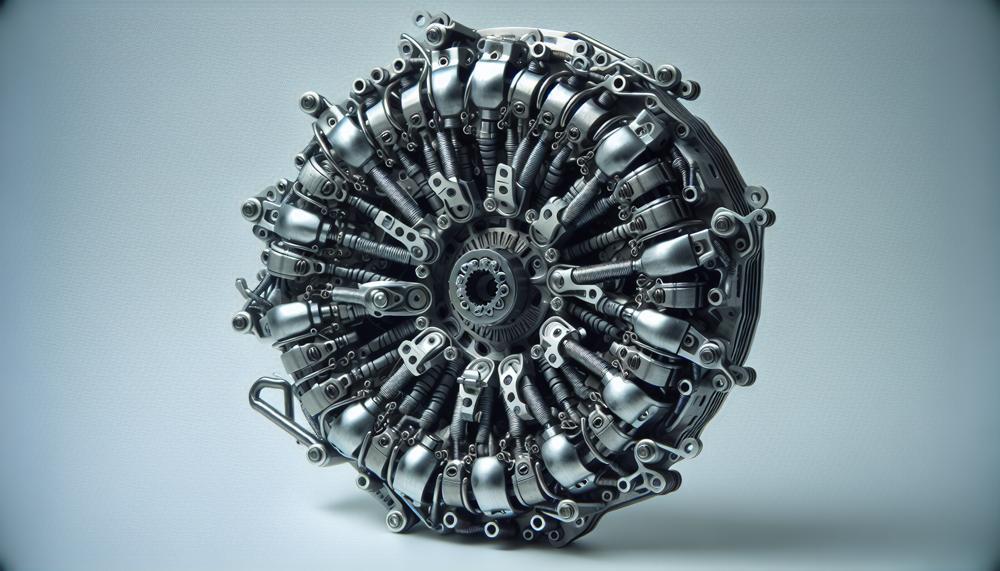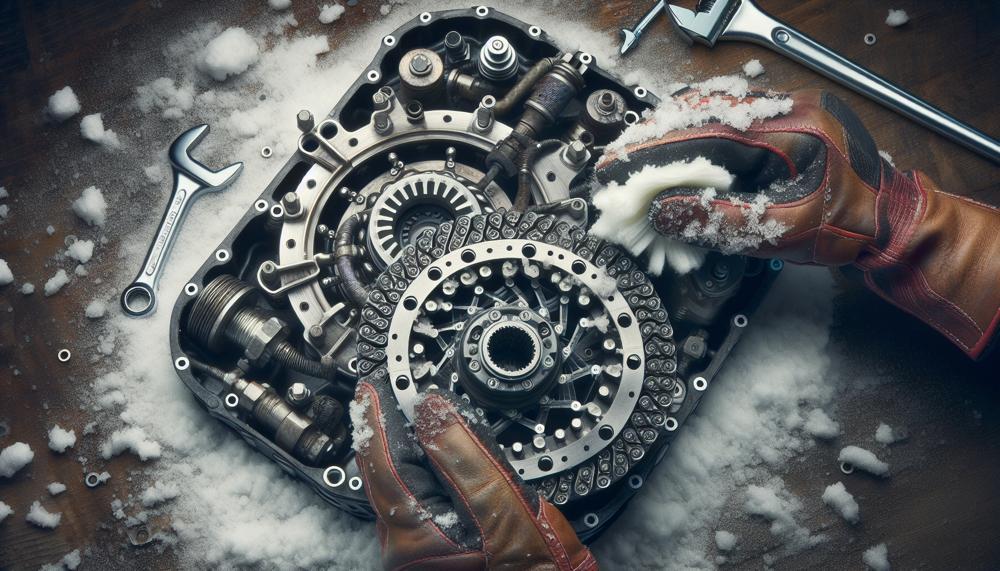Winter has arrived, and for snowmobile enthusiasts, that means it’s time to hit the trails. But before you rev up your engine and take off into the snowy wonderland, it’s crucial to ensure your machine is in top condition.
And one essential aspect of snowmobile maintenance is cleaning the clutch – the component responsible for transferring power from the engine to the track.
So, how do you clean snowmobile clutches?
Here are some ways to clean a snowmobile clutch:
- Rinse with warm water: This is the most thorough way to flush out metal debris and belt residue.
- Spray with brake cleaner: Spray the clutch with brake cleaner to flush out debris and then wipe it with a clean cloth. Brake cleaner can also be used on tough rubber or plastic bushings, o-rings, and more.
- Use dish soap and hot water: Some recommend using Dawn dish soap and hot water.
- Use Scotch Brite: Scuff up the clutch faces with a Scotch Brite pad to roughen up the surface so the belt grabs better.
- Use acid wash: Acid wash can bring out new surfaces.
- Use ether: Ether can be used to clean clutches.
By regularly cleaning your snowmobile’s clutches, you can ensure smooth operation and extend their lifespan.
So don’t let dirty clutches slow you down – follow these easy steps to keep your ride running at its best all winter long
Remember to make this part of your regular snowmobile maintenance routine for optimal performance on every ride.
Symptoms that Indicate Your Snowmobile Clutch is Bad
Contents
- 1 Symptoms that Indicate Your Snowmobile Clutch is Bad
- 2 What to do if Your Sled Has Clutch Issues
- 2.1 Understand the Crucial Role of the Clutch System:
- 2.2 Identify Early Indicators and Effective Solutions:
- 2.3 Conduct a Thorough Visual Inspection:
- 2.4 Perform a Spin Test:
- 2.5 Check Clutch Alignment:
- 2.6 Regularly Monitor Belt Condition:
- 2.7 Keep an Eye on Temperature:
- 2.8 Resolve Slipping Clutches:
- 2.9 Address Hard Shifting:
- 2.10 Eliminate Squealing Noises:
- 2.11 1Maintain Consistency:
- 3 How do You Check a Snowmobile Clutch?
- 4 How do You Remove a Snowmobile Clutch?
- 5 How do You Disassemble a Snowmobile Clutch?
- 6 How do you Clean a Snowmobile Clutch?
- 7 Should You Lube a Snowmobile Clutch?
- 8 How do You Adjust a Snowmobile Clutch?
- 9 How do You Rebuild a Snowmobile Clutch?
- 10 Conclusion
Here are some common symptoms that indicate a potential problem:
- Decreased acceleration and top speed: If you notice a decrease in your snowmobile’s speed and ability to accelerate, it could be a sign that your clutch needs attention. This could be due to worn-out parts or build-up of debris in the clutch system.
- Burnt smell from the clutch area: A burnt smell coming from your snowmobile’s clutch area is a clear indication that something is not right. It could be due to excessive friction between the clutch components, which can cause overheating and lead to severe damage if not addressed promptly.
- Strange noises while in operation: Pay attention to any unusual noises coming from your snowmobile while it’s running. A faulty clutch can produce grinding, rattling, or squealing sounds, which could indicate a need for cleaning or replacement.
- Change in fuel efficiency: If your snowmobile starts consuming more fuel than usual, it could be a sign of a bad clutch. A poorly functioning clutch can put extra strain on the engine, causing it to work harder and use more fuel.
To prevent these symptoms from occurring, regularly inspect and clean your snowmobile’s clutch. Follow proper cleaning techniques and use recommended products to extend the lifespan of your clutches and maintain optimal performance.
Remember, early detection is key to avoiding costly repairs in the future. So keep an eye out for these tell-tale signs and address any issues promptly.
What to do if Your Sled Has Clutch Issues
In the event that your snowmobile is experiencing clutch issues, it’s critical to take immediate action in order to ensure the safety and durability of your ride.
Here are the necessary steps you should follow to troubleshoot and resolve any clutch problems that may arise:
Understand the Crucial Role of the Clutch System:
The clutch system plays a vital role in the performance and functionality of a snowmobile. It is responsible for transferring power from the engine to the track, allowing you to shift gears and control your speed.
Being aware of its importance will help you recognize and address any potential issues that may arise.
Identify Early Indicators and Effective Solutions:
Pay close attention to early warning signs of clutch problems, such as slipping, difficulty shifting, overheating, or squealing noises. These can be indicative of worn or damaged components that require replacement.
Refer to reliable sources for effective solutions to these issues.
Conduct a Thorough Visual Inspection:
Before hitting the trails, perform a thorough visual inspection of your clutch system.
Look for any obvious signs of wear and tear, such as frayed belts or damaged parts. This will give you a better understanding of the overall health of your clutches.
Perform a Spin Test:
On level ground, perform a spin test to check for any issues with shifting gears or sudden thrusts.
This will help you identify any misalignments or tension problems that may need to be adjusted.
Check Clutch Alignment:
Utilize a straight edge or specialized alignment tool to ensure proper alignment of your clutches.
Misaligned clutches can lead to slippage, reduced performance, and even damage to other components.
Regularly Monitor Belt Condition:
The belt is a crucial component in the clutch system, as it helps transfer power from the engine to the track. Regularly check its condition for any wear or damage and replace it as needed.
Keep an Eye on Temperature:
After each ride, pay close attention to the temperature of your clutches as overheating can be an indication of potential problems.
Be sure to maintain proper alignment and consider using heat-resistant materials to prevent overheating.
Resolve Slipping Clutches:
If your clutches are slipping, this is a sign of worn or damaged components. Replace these parts to ensure proper functioning of your clutch system.
Address Hard Shifting:
Hard shifting can be caused by misalignments or tension issues. Carefully adjust these settings to improve shifting and overall performance.
Eliminate Squealing Noises:
Squealing noises can be a result of worn parts or lack of lubrication.
Replace any worn parts and use lubricants specifically designed for clutches to eliminate these noises.
1Maintain Consistency:
To ensure a smooth and enjoyable riding experience, make sure to regularly check for wear and tear on your clutch system.
This will help you catch any problems early on and keep your snowmobile running optimally.
How do You Check a Snowmobile Clutch?
When it comes to properly checking a snowmobile clutch, there are several steps that must be taken regularly to ensure its optimal performance.
These steps are crucial in maintaining the clutch’s good condition and avoiding any potential issues while riding.
Let’s take a closer look at these steps:
- Refer to the service manual: Before you begin checking or performing maintenance on the clutch, it is essential to consult your snowmobile’s service manual for specific instructions and specifications.
- Remove the clutch: The first step is to remove the clutch from the engine of your snowmobile. This can be done by loosening the bolts that secure the clutch in place and carefully taking it out.
- Inspect for wear and tear: Once the clutch is removed, carefully inspect it for any signs of wear and tear. Look out for cracks, chips, or any other damage that could affect its performance.
- Thoroughly clean the clutch: It is essential to clean the clutch thoroughly using compressed air or hot soapy water. This will help remove any dirt, debris, or buildup that may have accumulated over time.
- Lubricate if necessary: Depending on the specific instructions from your service manual, some parts of the clutch may require lubrication to prevent friction and ensure smooth operation.
- Adjust tension: Using an external adjuster, follow the manufacturer’s specifications to adjust the tension of the clutch. This will ensure proper engagement and disengagement of the clutch.
- Reinstall the clutch: After completing all inspections, cleaning, and adjustments, reinstall the clutch back onto the engine and securely tighten the bolts.
By regularly following these steps, you can rest assured that your snowmobile’s clutch is in excellent working condition and ready for your next ride.
How do You Remove a Snowmobile Clutch?
When it comes to removing a snowmobile clutch, there are a few essential tools you’ll need to get the job done. These include an impact wrench or hand wrench, a socket, tape, water (or oil/grease), and a Grade 8 bolt with a matching thread pitch. Once you have all your tools ready, the process starts with flipping the snowmobile onto its side. This allows for easier access to the clutch bolt.
Next, you’ll need to remove the clutch bolt using your wrench and socket. This may require some force, so be prepared to use some muscle. Once the bolt is removed, it’s time to create hydraulic pressure using the bolt and water. This is where the tape comes in handy as it helps seal any gaps between the bolt and clutch.
With hydraulic pressure in place, you can now carefully remove the clutch from the snowmobile. It’s important to note that this process may require some finesse and patience as you don’t want to damage any other parts of your snowmobile. Once the clutch is removed, you can proceed with any necessary repairs or replacements.
As mentioned earlier, this method has been tried and tested by the author who has extensive experience with snowmobiles and repairs.
So if you’re looking for a reliable way to remove your snowmobile clutch, give this method a try.
How do You Disassemble a Snowmobile Clutch?
Disassembling a snowmobile clutch is a crucial aspect of regular maintenance to ensure its optimal performance and durability. Here is an easy-to-follow guide on how to disassemble a snowmobile clutch for cleaning:
- Gather your tools: Before starting the disassembly process, make sure you have all the necessary tools on hand. These may include a socket wrench, socket, puller, and safety gear such as gloves and goggles.
- Remove the drive belt: Begin by taking off the drive belt from the clutch. This will make it easier for you to access the bolts and components of the clutch.
- Unscrew the clutch cover: Using a socket wrench, unscrew the bolts that are holding the clutch cover in place. Once removed, carefully take off the cover and set it aside.
- Loosen the main bolt: With a socket wrench or a specialized puller tool, loosen the main bolt that secures the clutch in place. This may require some strength and should be done gradually to avoid damaging the clutch.
- Take out the clutch: After loosening the main bolt, use your hands or a puller tool to cautiously remove the clutch from the shaft.
- Clean each component: With the clutch removed, thoroughly clean each component using a degreaser. Be sure to eliminate any accumulated dirt, grime, or debris from every part.
- Inspect for any damage: While cleaning each component, check for any signs of damage or wear. If any parts seem damaged or worn out, they may need to be replaced before reassembling the clutch.
- Reassemble the clutch: Once all components are cleaned and inspected, reassemble the clutch in reverse order of disassembly. Make sure to securely tighten all bolts and reattach the drive belt.
- Test its functioning: Before taking your snowmobile out for a ride, start it up and test the clutch to ensure it is working correctly.
By following these steps, you can effectively disassemble a snowmobile clutch for cleaning and maintenance.
How do you Clean a Snowmobile Clutch?
| Step | Action | Tools Needed |
| 1 | Collect Essential Tools | L-bolt tool, air compressor, brake cleaner, abrasive pad |
| 2 | Remove the Drive Belt | L-bolt tool |
| 3 | Loosen the Clutch Cover | Socket wrench |
| 4a | Clean the Clutch On-Sled (Quick Clean) | Air compressor, brake cleaner, abrasive pad |
| 4b | Deep Clean the Clutch | Brake cleaner, abrasive pad |
| 5 | Reassemble and Test Functionality | Socket wrench, torque wrench (to spec) |
By following these steps, you can effectively clean your snowmobile clutch and maintain its optimal performance.
Should You Lube a Snowmobile Clutch?
Frequently lubricating a snowmobile clutch is of utmost importance as it aids in decreasing friction, avoiding early deterioration, and preserving fuel efficiency.
Failing to lubricate a snowmobile clutch can result in costly repairs, diminished performance, and potential safety hazards such as accidents or being stranded in remote locations.
How do You Adjust a Snowmobile Clutch?

Adjusting a snowmobile clutch is an important maintenance task that can significantly improve the performance of your sled.
It is crucial to regularly follow these steps to ensure that your snowmobile’s clutch is properly adjusted for optimal performance.
| Steps | Actions | Notes |
| 1 | Clean clutches and belt regularly | Use degreaser and clean cloth to remove dirt and debris |
| 2 | Check belt tension and alignment | Ensure correct alignment and tension as per manufacturer’s specifications |
| 3 | Adjust clutch engagement RPM | Refer to manufacturer’s instructions for specific guidelines |
| 4 | Replace worn or damaged parts | Inspect for wear and tear and replace promptly |
| 5 | Use high-quality lubricants | Specifically designed for snowmobile clutches to reduce friction and increase efficiency |
Regularly performing these steps will ensure that your snowmobile’s clutch is properly adjusted for optimal performance. It is recommended to check and adjust the clutch at the beginning of each riding season and regularly throughout the season to maintain top performance.
Remember to always refer to the manufacturer’s instructions for specific guidelines for your snowmobile model.
How do You Rebuild a Snowmobile Clutch?
Rebuilding a snowmobile clutch is no easy task, but with the right tools and steps, it can be successfully accomplished. Here is a comprehensive guide on the necessary steps and tools required to rebuild a snowmobile clutch:
- Gather the Essential Tools and Parts: Before diving into the rebuilding process, ensure that all necessary tools and parts are available. Some of the tools you may need include a clutch puller, impact wrench, flywheel holder, and any replacement parts specific to your snowmobile’s clutch model.
- Carefully Remove the Clutch from the Snowmobile: Using a clutch puller, remove the clutch from the snowmobile. It is crucial to follow the instructions for your specific model to avoid causing any damage.
- Disassemble the Clutch: Once removed, disassemble the clutch by removing all bolts and separating its components. Make sure to take note of the order in which the parts are stacked as it will make reassembly easier.
- Thoroughly Inspect for Wear and Damage: Take a close look at all parts of the clutch for any signs of wear or damage. If any parts are worn out or damaged, replace them with new ones.
- Clean and Lubricate: Use hot soapy water to clean all components of the clutch. Avoid using harsh chemicals that may cause damage. After cleaning, apply a high-quality lubricant to all moving parts.
- Reassemble the Clutch: Using your earlier notes, reassemble the clutch in the correct order. Make sure all bolts are tightened according to the correct specifications.
- Reinstall on Snowmobile: Once reassembled, carefully reinstall the clutch onto your snowmobile using a flywheel holder and impact wrench.
- Test and Adjust: Start your snowmobile and test the clutch’s performance. If necessary, make adjustments to tension and alignment for optimal performance.
- Regular Maintenance: To prevent the need to rebuild your snowmobile’s clutch in the future, make sure to regularly check and clean it as part of your maintenance routine. This will help prolong its lifespan and ensure it performs at its best.
Conclusion
As the winter season sets in, snowmobile enthusiasts eagerly anticipate hitting the trails. But before you embark on your snowy adventure, it’s crucial to ensure your machine is in top condition. And one essential aspect of snowmobile maintenance is cleaning the clutch – the component responsible for transferring power from the engine to the track.
To help you keep your snowmobile running smoothly, we’ve covered everything you need to know about cleaning and maintaining its clutches. First, gather the necessary tools including a clean cloth, brake cleaner, and a brush or toothbrush. Then follow our step-by-step guide on removing and cleaning your clutches, complete with tips on inspecting for wear and reassembling correctly.
Be on the lookout for common symptoms that indicate a potential problem with your snowmobile’s clutch, such as decreased acceleration or strange noises while in operation. Regularly cleaning and inspecting your clutches can prevent these issues from arising.






